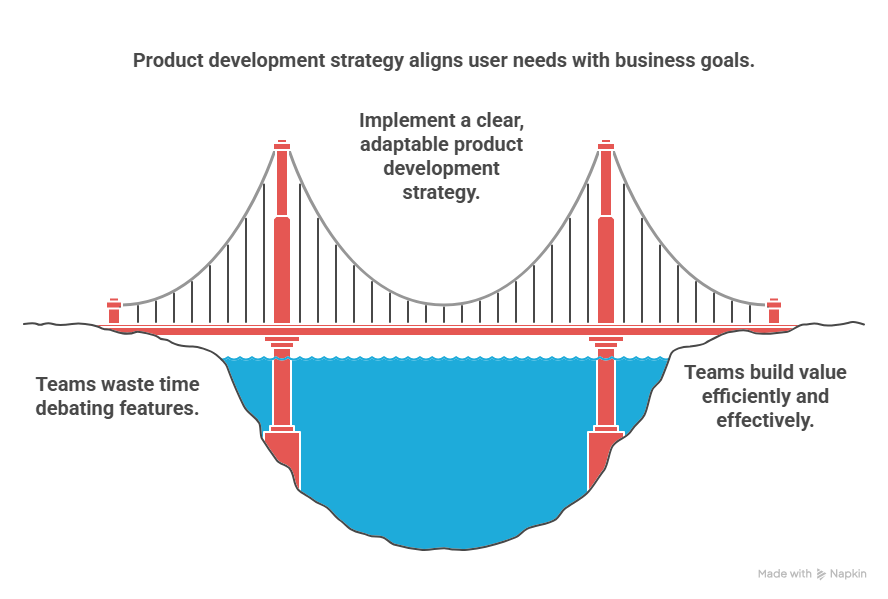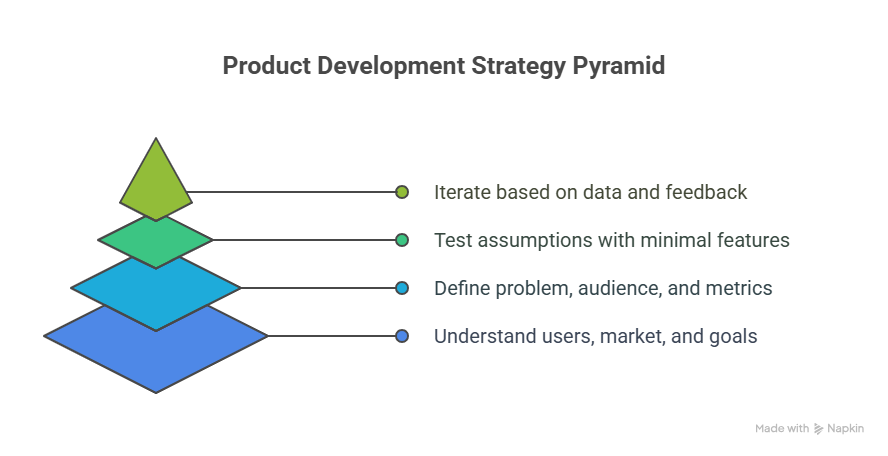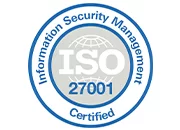A good idea isn’t enough. If your product development strategy is off, your product won’t land, no matter how innovative it looks on paper.
I’ve seen it happen too often: teams invest months building features no one uses, launch too early without validation, or get stuck endlessly iterating without direction. If that sounds familiar, it’s not a failure of effort. It’s a strategy problem.
In this blog, I’ll break down why many product development strategies fall apart and what you can do to fix yours, whether you’re building a new product from scratch or trying to turn a stagnant one around.
What is a Product Development Startegy(Really)?

Most teams confuse a product development strategy with a feature roadmap or a release schedule. But those are just outputs. A product development strategy is the why and how behind building the right product, not just building fast.
It’s your plan for:
- Solving a real user problem
- Aligning that problem with business goals
- Deciding how to deliver and evolve the solution over time
A good strategy defines who the product is for, what outcome it’s supposed to create, and how you’ll know it’s working. It links user needs to technical decisions. And when it’s clear, teams waste less time debating features and more time building value.
If your strategy only lives in a deck or gets revisited once a year, it’s not helping your product. In fast-moving markets, a real strategy lives in your process, and adapts with what you learn.
Why Product Development Strategies Fail
I’ve worked with teams that had strong ideas, talented developers, and a clear market, but still missed the mark. Not because they didn’t work hard, but because their product development strategy wasn’t doing its job.
Here’s where most strategies go wrong:
- No real user validation
Teams assume what users want instead of asking them. That leads to products built on guesswork rather than real problems. - Building for internal opinions, not the market
Features get prioritized based on stakeholder input, not user value. Internal alignment overrides external demand. - Poor alignment between business, product, and engineering
When these functions work in silos, product teams chase the wrong outcomes. Strategy must align everyone around a shared objective. - Too much focus on features, not outcomes
Launching features feels like progress. But if you’re not measuring impact, retention, adoption, revenue, you’re flying blind. - No iteration plan post-launch
Many teams ship and move on. Without feedback loops, usage data, or a roadmap for learning, your strategy becomes static while your market moves.
How to Fix a Failing Product Development Strategy
If your strategy isn’t delivering, the good news is: you don’t need to start over. You need to realign.
Here’s how I help teams course-correct their product development strategy:
- Start with real user problems, not assumptions
Don’t build around ideas. Build around pain points that users would pay to solve. Jobs-to-be-Done interviews, user shadowing, or even sales feedback can uncover what matters most. - Validate before you build
Test concepts early, with mockups, landing pages, or low-code prototypes. This reduces risk and saves time later. - Align on outcomes, not features
Get everyone, product, business, and tech, focused on user outcomes. Features should serve a measurable result, like activation rate or reduced churn. - Use lean, adaptive workflows
Adopt an agile or dual-track development process. It keeps discovery and delivery in sync so your product evolves with your understanding of the user. - Build in feedback loops
Don’t wait until after launch to learn. Create ways to collect insights at every step, whether through analytics, direct user feedback, or iterative releases. - Tie the strategy to business goals
A solid product strategy connects directly to revenue, retention, or market share. Without that link, even well-built products can fall flat.
Fixing your strategy is less about rewriting documents, and more about fixing how you decide what to build, why, and when.
A Product Development Strategy Framework That Works

There’s no one-size-fits-all strategy. But there is a structure that consistently helps teams deliver the right product, at the right time, without wasting resources. Here’s the framework I recommend and follow with most clients:
1. Discovery & Research
Before anything is built, spend time understanding your users, the problem space, and the market. This includes:
- Customer interviews
- Jobs-to-Be-Done mapping
- Competitor analysis
- Internal goal alignment
2. Strategy Alignment
Translate research into a clear product direction. At this stage, define:
- The core problem to solve
- Who you’re building for
- Key success metrics (business and user)
- Risks and assumptions to test
3. Lean MVP Build
Build only what’s necessary to test your riskiest assumptions. Focus on speed, usability, and value, not feature count. Ship something usable early to a real audience.
4. Continuous Delivery & Optimization
After launch, the work doesn’t stop. Analyze usage, collect feedback, and iterate fast. Let data and customer behavior shape what you build next.
This framework helps turn product development from a guessing game into a repeatable, focused process. And it ensures your product development strategy evolves with your users, not in spite of them.
Product Development Strategy Framework (At a Glance)
| Stage | What It Involves | Why It Matters |
| 1. Discovery & Research | Customer interviews, JTBD, competitor analysis, goal alignment | Ensures you’re solving the right problem for the right audience |
| 2. Strategy Alignment | Define core problem, user persona, success metrics, risks | Aligns business, product, and tech around shared objectives |
| 3. Lean MVP Build | Build only what’s needed to test assumptions and deliver value | Reduces risk, speeds up feedback, and prevents overbuilding |
| 4. Continuous Optimization | Analyze usage, gather feedback, iterate on real data | Keeps your strategy adaptive and user-driven |
Build Smarter, Not Just Faster
A failing product development strategy doesn’t always look like failure. Sometimes it looks like progress, just the wrong kind. Features ship, timelines move, but adoption stalls, and users don’t stick.
Fixing that isn’t about doing more. It’s about being intentional with what you build, why you build it, and who you’re building for.
At WildnetEdge, we work with teams to create product strategies that don’t just look good in presentations; they work in the real world. We help you validate ideas, build lean, and deliver products that your users actually need.
If your strategy isn’t delivering the results you expected, let’s talk about how to fix it, and what better could look like.
FAQs
1. What is a product development strategy?
Ans. A product development strategy is a structured plan that guides how a business creates and evolves a product, from understanding user needs to aligning with business goals and delivering value over time. It’s more than a roadmap or feature list; it’s the foundation for building the right product, not just building fast.
2. How do I know if my product development strategy is failing?
Ans. Some common signs include low user adoption, features going unused, unclear team priorities, or constant changes in direction. If you’re shipping features without clear outcomes, or your team isn’t aligned around user value, it’s time to revisit your strategy.
3. What’s the difference between a product roadmap and a product development strategy?
Ans. A roadmap is a timeline of features and releases. A strategy is the “why” behind those features, it aligns business goals, user needs, and market context. The roadmap is tactical; the strategy is directional.
4. Can I fix my product development strategy without starting over?
Ans. Yes. Often, it’s about reworking how you prioritize, validate, and learn. You can keep your product and tech intact but reframe how you define problems, measure success, and align your team around outcomes.
5. What framework should I follow to improve my strategy?
Ans. Start with a simple 4-stage approach:
- Discovery & Research
- Strategy Alignment
- Lean MVP Build
- Continuous Delivery & Optimization
This framework helps keep your strategy user-centric, adaptive, and measurable.

Nitin Agarwal is a veteran in custom software development. He is fascinated by how software can turn ideas into real-world solutions. With extensive experience designing scalable and efficient systems, he focuses on creating software that delivers tangible results. Nitin enjoys exploring emerging technologies, taking on challenging projects, and mentoring teams to bring ideas to life. He believes that good software is not just about code; it’s about understanding problems and creating value for users. For him, great software combines thoughtful design, clever engineering, and a clear understanding of the problems it’s meant to solve.
 sales@wildnetedge.com
sales@wildnetedge.com +1 (212) 901 8616
+1 (212) 901 8616 +1 (437) 225-7733
+1 (437) 225-7733















 ChatGPT Development & Enablement
ChatGPT Development & Enablement Hire AI & ChatGPT Experts
Hire AI & ChatGPT Experts ChatGPT Apps by Industry
ChatGPT Apps by Industry ChatGPT Blog
ChatGPT Blog ChatGPT Case study
ChatGPT Case study AI Development Services
AI Development Services Industry AI Solutions
Industry AI Solutions AI Consulting & Research
AI Consulting & Research Automation & Intelligence
Automation & Intelligence















